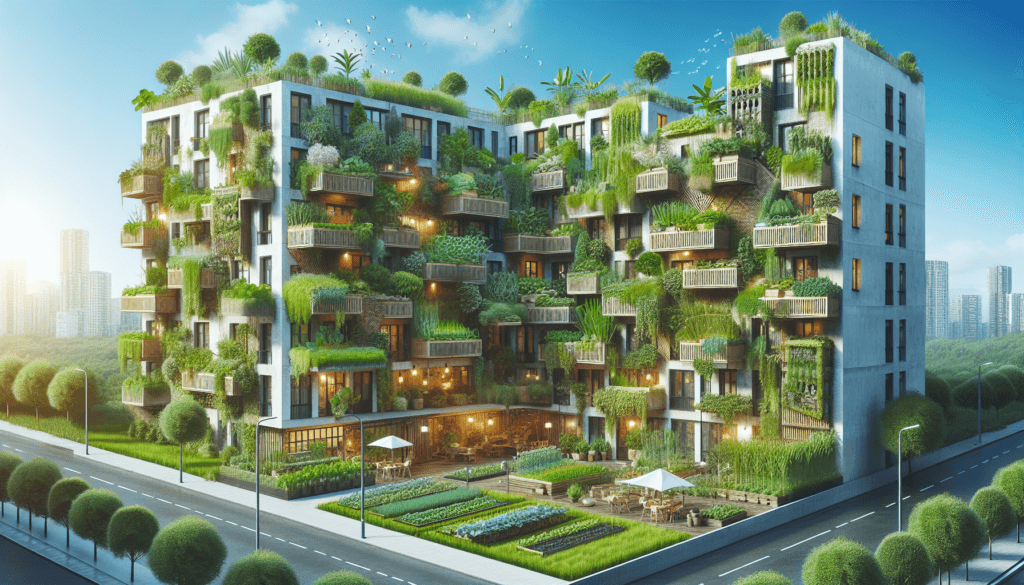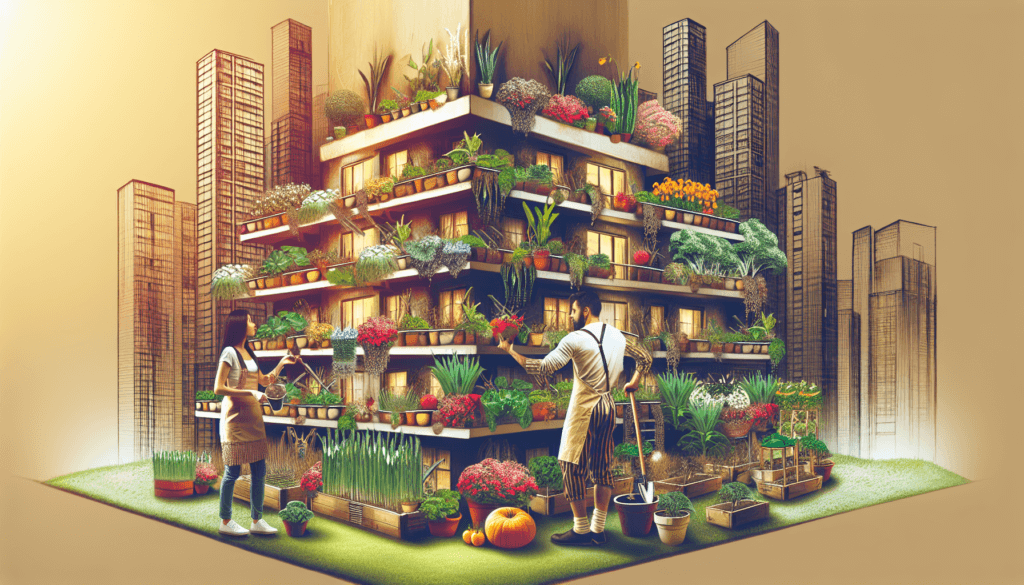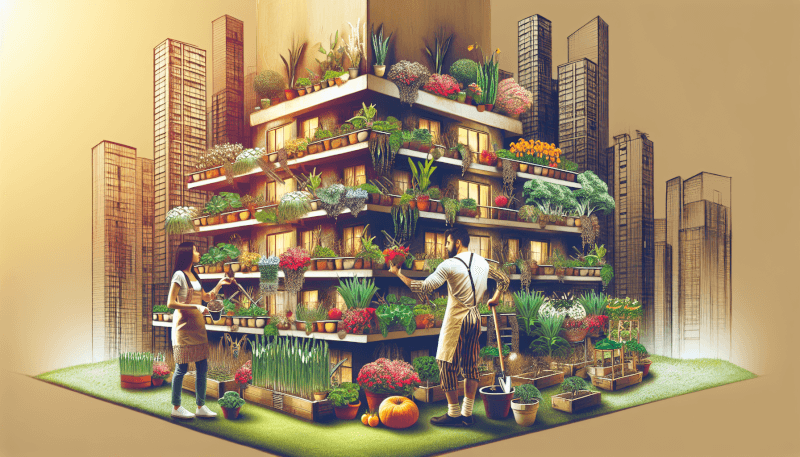Living in an apartment doesn’t mean you have to give up the joy of gardening. Urban gardening offers a wonderful opportunity for apartment dwellers to connect with nature and grow their own plants, even without a yard. With a bit of creativity and some practical tips, you can transform your apartment into a thriving oasis of greenery. In this article, we will explore various ways to successfully cultivate a garden in your apartment, whether you have a tiny balcony, a sunny windowsill, or just a few pots to spare. Get ready to embrace the joys of urban gardening and bring some nature into your urban space.
Choosing the Right Plants
Consider sunlight requirements
When choosing plants for your apartment garden, it’s important to consider their sunlight requirements. Take note of the amount of natural light your apartment receives throughout the day. Some plants thrive in direct sunlight, while others do better in partial shade or even full shade. By understanding the sunlight requirements of your chosen plants, you can ensure that they will flourish in your space.
Select plants suited for small spaces
Living in an apartment often means limited space for gardening. However, there are plenty of plants that are well-suited for small spaces. Opt for compact varieties of your favorite plants or look for dwarf varieties specifically bred for limited space. Additionally, consider plants that can be grown in hanging baskets, vertical planters, or on windowsills. These space-saving options allow you to enjoy the beauty of plants even in the smallest of apartments.
Choose plants that are low-maintenance
While apartment gardening can be a rewarding and fulfilling hobby, it’s important to choose plants that fit into your lifestyle and time constraints. If you have a busy schedule and limited time to dedicate to gardening, opt for plants that are low-maintenance. Look for plants that require minimal watering, pruning, and fertilizing. This way, you can enjoy the benefits of a green space without feeling overwhelmed by the upkeep.
Container Gardening
Select appropriate containers
Choosing the right containers is essential for successful container gardening. Ensure that the containers you select have drainage holes to prevent waterlogging and root rot. The size of the container should be suitable for the plant’s root system and allow for proper growth. Consider using containers made from durable materials such as plastic, ceramic, or terracotta, as they will withstand the elements and last longer.
Use good quality soil
The quality of the soil in your containers plays a crucial role in the health and growth of your plants. Use a high-quality potting mix that is well-draining and nutrient-rich. Avoid using garden soil, as it may not provide adequate drainage and can introduce pests or diseases to your plants. Amending your potting mix with organic matter such as compost or peat moss can further improve its quality and fertility.
Consider vertical gardening
When space is limited, exploring vertical gardening techniques can maximize your gardening potential. Vertical gardening involves utilizing walls, trellises, or hanging planters to grow plants vertically instead of horizontally. This not only saves space but also adds visual interest to your apartment. Consider growing vining plants such as ivy or climbing roses, or use hanging planters to grow trailing plants like Boston ferns or pothos vines.

Indoor Gardening
Identify suitable indoor spaces
Indoor gardening allows you to bring the beauty of nature into your apartment, even without access to an outdoor yard. Identify suitable indoor spaces that receive sufficient natural light and have good air circulation. South-facing windows typically provide the most sunlight, making them ideal for sun-loving plants. East or west-facing windows can also be suitable for plants that prefer partial shade. Additionally, consider utilizing shelves, bookcases, or even wall-mounted planters to maximize your indoor gardening space.
Provide adequate lighting
In apartments with limited natural light, supplementing with artificial lighting is essential for successful indoor gardening. Choose full-spectrum grow lights specifically designed for plants and position them close to your plants to provide adequate light intensity. Pay attention to the duration of light exposure as well, ensuring your plants receive the appropriate amount of light each day. By providing the right lighting conditions, you can ensure healthy growth and vibrant foliage for your indoor plants.
Use self-watering containers
One of the challenges of indoor gardening is maintaining proper watering techniques. Self-watering containers can help regulate moisture levels and prevent over or underwatering. These containers have a reservoir at the bottom that slowly delivers water to the plant’s roots as needed. This not only saves you time and effort but also promotes healthier root growth and reduces the risk of root rot. Consider investing in self-watering containers to simplify your indoor gardening routine.
Herb Gardens
Start with easy-to-grow herbs
If you’re new to gardening or have limited experience, starting with easy-to-grow herbs is a great way to get started. Herbs such as basil, mint, parsley, and chives are relatively low-maintenance and forgiving plants. They require minimal space, can be grown in containers, and provide fresh flavors for your culinary creations. Starting with these herbs allows you to gain confidence and experience before expanding your herb garden further.
Use hanging planters for herb gardens
Space-saving techniques such as using hanging planters are particularly useful for growing herb gardens in apartments. Hang small herb planters near your kitchen window or on a balcony railing to make the most of vertical space. This allows for easy access to fresh herbs while also adding a decorative touch to your apartment. Herbs like thyme, oregano, and rosemary do well in hanging planters and can provide a fragrant and flavorful addition to your cooking.
Rotate herbs for continuous growth
To maintain a healthy herb garden, it’s important to practice proper care and cultivation techniques. A useful technique is to rotate your herbs periodically. This involves replanting or propagating new herb plants while allowing existing ones to rejuvenate. By rotating your herbs, you can ensure a continuous supply of fresh and flavorful leaves. Additionally, it helps prevent overcrowding and encourages proper circulation of air and sunlight, contributing to healthier plants.

Vertical Gardening
Install a vertical trellis or wall garden
Vertical gardening offers a creative and space-efficient method for apartment dwellers to enjoy the beauty of plants. Installing a vertical trellis or wall garden allows you to grow climbing or trailing plants along walls or fences. This not only adds a stunning green backdrop to your apartment but also maximizes your planting space. Choose sturdy structures that can support the weight of the plants and secure them properly to ensure stability and safety.
Choose plants that climb or trail
When practicing vertical gardening, selecting the right plants is crucial for success. Choose climbing plants such as sweet peas, clematis, or morning glories, as they naturally cling to vertical supports. Trailing plants like trailing petunias or English ivy are also excellent choices for cascading down from hanging baskets or wall-mounted planters. Consider the growth habits and requirements of the plants you choose to ensure they are suitable for vertical gardening.
Consider using a shoe organizer for vertical gardening
An inventive and affordable solution for vertical gardening in apartments is repurposing a shoe organizer. Hang a fabric shoe organizer on a wall or door, fill each pocket with potting soil, and plant herbs or small vegetables in each compartment. This clever DIY vertical garden allows you to grow a variety of plants in a compact space. Additionally, the pockets provide good drainage and airflow, ensuring healthy growth for your plants.
Hydroponics
Understand the basics of hydroponics
Hydroponics is a soilless gardening method that allows you to grow plants in a nutrient-rich water solution. Understanding the basics of hydroponics is essential before setting up your own hydroponic system. Research different types of hydroponic systems, such as Deep Water Culture or Nutrient Film Technique, and familiarize yourself with the necessary equipment and supplies. By understanding the principles behind hydroponics, you can ensure a successful and thriving indoor garden.
Set up a simple hydroponic system
Setting up a simple hydroponic system in your apartment is an exciting way to explore this innovative gardening method. Start with a small-scale system and gradually expand as you gain experience and confidence. Purchase or build a hydroponic system that suits your available space and needs. Ensure proper lighting and ventilation for your plants, and closely monitor nutrient levels and pH balance. With proper care and attention, you can enjoy the benefits of hydroponic gardening in your apartment.
Use appropriate nutrients for hydroponic gardening
In hydroponic gardening, plants rely on a nutrient solution for their growth and development. It’s important to use the appropriate nutrients specifically formulated for hydroponic systems. These nutrient solutions contain essential elements that plants need for healthy growth, such as nitrogen, phosphorus, and potassium. Additionally, regular monitoring and adjustment of nutrient levels according to the plant’s growth stage are crucial to ensure optimal health and productivity.

Companion Planting
Pair compatible plants together
Companion planting is a gardening technique that involves growing compatible plants together to enhance their growth and deter pests or diseases. When practicing companion planting, consider the needs and characteristics of different plants to ensure compatibility. For example, planting marigolds alongside tomatoes can help deter pests, while growing basil near beans can enhance their flavor. By strategically pairing plants, you can create a harmonious and beneficial garden ecosystem.
Use companion plants for natural pest control
One of the advantages of companion planting is its natural pest control properties. Certain plants emit natural chemicals or scents that repel pests and insects. By interplanting pest-repellent plants with your desired crops, you can deter harmful pests without resorting to chemical pesticides. For example, planting chives near roses can help repel aphids, while planting garlic near brassicas can deter cabbage worms. Embrace the power of companion planting to promote a healthy and pest-free garden.
Benefit from companion plants’ mutual benefits
Companion plants not only protect against pests but also provide mutual benefits to each other. Some plants have nutrient requirements that complement each other, while others offer shade or act as natural mulch. For example, interplanting beans with corn allows the beans to climb the corn stalks, and the beans, in turn, fix nitrogen in the soil, benefiting both plants. By harnessing the synergistic relationships between companion plants, you can create a thriving and harmonious garden ecosystem.
Balcony Gardens
Consider weight limitations on the balcony
When planning a balcony garden, it’s important to consider the weight limitations imposed by your balcony’s construction. Ensure that your balcony can safely support the weight of plants, containers, and accessories. Consider lightweight containers and potting mixes to reduce the overall weight. Consult with a structural engineer or building management if you have any concerns about the balcony’s load-bearing capacity. Safety should always be the top priority when creating a balcony garden.
Use railing planter boxes for additional space
Make the most of the vertical space on your balcony by using railing planter boxes. These clever containers attach to the balcony railing, allowing you to grow plants while maximizing your usable space. Choose plants that are suitable for the height and exposure of your balcony. Flowers such as petunias or geraniums can add a burst of color, while herbs like rosemary or thyme are both decorative and useful for cooking. Railing planter boxes offer a simple and effective solution for balcony gardening.
Create privacy with tall plants or trellises
If privacy is a concern on your balcony, consider using tall plants or trellises to create a natural barrier. Bamboo or tall grasses can help create a sense of seclusion and add a touch of tranquility to your outdoor space. Alternatively, install trellises and train climbing plants such as jasmine, clematis, or creeping fig to grow vertically, creating a living green wall. These privacy-enhancing techniques not only provide a sense of solitude but also add beauty and tranquility to your balcony garden.

Community Gardens
Research nearby community gardens
If you don’t have access to a private outdoor space, consider joining or researching nearby community gardens. Community gardens provide individuals with the opportunity to grow their own plants in shared spaces. Research local community gardens in your area, inquire about availability, and learn about their rules and regulations. Visit the gardens to get a sense of the environment and community spirit. Joining a community garden can provide you with a larger gardening space and the chance to connect with fellow gardeners.
Apply for a plot in a community garden
Once you’ve found a community garden that suits your needs, apply for a plot. Most community gardens have a waiting list, so it’s important to apply in advance and be patient. Fill out the necessary paperwork, pay any required fees, and familiarize yourself with the garden’s guidelines and expectations. Treat your community garden plot as your own and respect the shared space and the efforts of your fellow gardeners. Joining a community garden can offer you a supportive gardening community and access to a larger gardening space.
Participate in gardening events and workshops
Community gardens often host various gardening events and workshops that are open to all members. Take advantage of these opportunities to expand your gardening knowledge and skills. Attend workshops on topics such as organic gardening, composting, or seed starting. Participate in community planting days or harvesting parties to foster a sense of camaraderie and lend a helping hand to fellow gardeners. Engaging in these community activities not only enhances your gardening experience but also allows you to contribute to the wider gardening community.
Conclusion
Urban gardening provides apartment dwellers with the opportunity to bring the beauty and benefits of plants into their living spaces. By choosing the right plants based on sunlight requirements and space limitations, you can create a thriving garden even in a small apartment. Container gardening, indoor gardening, herb gardens, vertical gardening, hydroponics, companion planting, balcony gardens, and community gardens offer different approaches to suit various living situations and preferences. With a bit of creativity and enthusiasm, apartment dwellers can enjoy the joys of gardening and reap the rewards of a green and vibrant environment.



